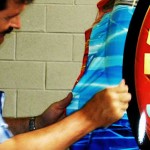Using application fluids isn’t rocket science, but it’s not child’s play, either. Discover what you need to know to make the most of application fluids. Read more »
Reflective Heat Transfer Films
Attention-getting films provide motorists with advance warning to prevent accidents. Most people avoid the limelight. Others need to be seen. This is especially true of people, who work and play in poor visibility environments. By wearing garments decorated RTape/SEF ReflexCut retro-reflective heat transfer films, these people get all the attention they desire. Read more »
When Ink Is Not the Problem with Digital Printing, Part II
Beyond dust and dirt, several factors impact the ink’s ability to stick to the substrate. The carrier aqueous-based or solvent-based is another key factor in the final outcome. Then there’s calibration. Read more »
Picture Perfect Wall Graphics
Applications to Smooth Walls Applying graphics to a flat, smooth, painted wall is easy. Still problems can and do occur. Rarely are these graphics failures the result of application technique. Instead improper surface preparation and poor material choices account for most problems. If you follow the few simple rules in this article, your applications should […] Read more »
Preparing Floors for Floor Graphics
Learn how to how to laminate the graphic, how to place it, how to prep the surface, and how to install the graphic so it will stay put and do its job. With floor graphics representing a $2 billion industry, can you really afford not to get involved? The answer for most of you is […] Read more »
What You Need to Know About Varnish in the Digital Printing Arena
There’s more than one way to varnish. And there’s more than one way to make a mess with varnish, too. The good news is, if you use the right printer and the right materials, varnishing can add profits to your bottom line. Read more »
Why Install Graphics in a Relaxed State
Years ago professional decal installers were taught to install vinyl graphics in a relaxed state without stretching the film. While vinyl films today are much more robust and can withstand the stresses encountered when wrapping a vehicle, you are much less likely to experience film failure, if you adhere to some of the old rules. […] Read more »
Application Temperature Range

To avoid problems with vinyl or any other pressure-sensitive material, carefully read the vinyl manufacturer’s technical data sheet. Product bulletins will usually contain all of the information you need, including application temperature range. The application temperature range for most vinyl films is usually between 50⁰ and 90⁰F (10⁰ to 32⁰ C). For some films, the […] Read more »
Problems with Static Electricity

In much of the country September ushers in climatic changes. As the autumn air becomes colder, the humidity of the air outdoors decreases. The drop in humidity can result in an increase of problems related with static electricity. Static problems in print shops are further exacerbated, as we switch from air conditioning to a heating […] Read more »
Adhesion Testing
Testing the Bond of an Ink or Paint Whether you are screen printing or painting, the coating must bond to the substrate for the service life of the product. Depending on the physical properties of the coating that you have selected for a project and the substrate to which the coating will be applied, the […] Read more »


